TRAINING NOTEBOOK ❘ By Jeremy Rifflard
In trench rescue, your goal is to make a safe zone around the injured or trapped worker as well as the rescuers. To accomplish this, you move panels into position near the worker. The area around the worker is not safe for entry until you have secured the panels with pressurized horizontal shores. Regardless of the types of shores you choose (wood, pneumatic, or hydraulic), you cannot fully pressurize them without putting some type of resistance or backfill behind the trench panels. Without resistance, the shores keep pushing the panels outward until the shores are ineffective. You need resistance behind the panels to allow the shores to pressurize, which, in turn, creates a safe zone (photo 1).
After you have inserted panels into the trench, you must secure them with shores. Secure the shores with 50 to 100 pounds per square inch (psi) of pressure—called a soft shoot. If you have a trench wall deformity and add more pressure, the panels may move out of position without backfill. Eventually, you want to hard shoot the pressure to 150 to 200 psi.
RELATED FIREFIGHTER TRAINING
Trench Rescue: Niles (IL) Fire Department
Trench shores are strongest when they are installed 90° to a pair of trench panels. Too much soil behind the panel may push the bottoms of the panels inward and create a lean greater than 15°, which can lead to shore weakening or failure. Avoid this whenever possible.
According to Battalion Chief Anthony Gonzalez, lead trench rescue instructor at Coral Springs (FL) Regional Institute of Public Safety, don’t give soil the opportunity or space to move. Make as much contact with your equipment as you can to minimize the chance of soil movement. This will limit the potential for system failure from moving soil.
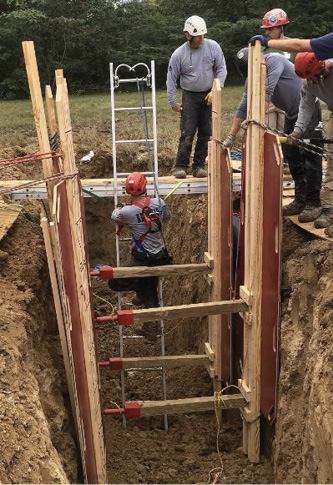
(1) A safe zone is created by pressurizing shores onto trench panels. (Photos by author unless otherwise noted.) (2, 3) Sandbags are an inexpensive tool to use on scene to control soil. You can quickly fill them and place them behind a trench panel.


(2, 3) Sandbags are an inexpensive tool to use on scene to control soil. You can quickly fill them and place them behind a trench panel.
The most common material for backfill is the soil that was removed to create the trench. In most cases, there is a spoil pile of the removed soil just a few feet away.
Depending on the soil type and moisture and type of trench wall collapse, the soil may run out the sides or bottoms of the trench panels. How can you avoid this? Use some method of creating compartments to keep backfill where you want it. If the walls are fairly straight, you may be able to compartmentalize the area with a 2 × 4 that you slide vertically along each side of the panel. This technique is not usually effective if there is a large failure of the trench walls. Any large divots bigger than a five-gallon bucket create a pocket where soil can escape.
Sandbags are an inexpensive tool to contain soil to a particular shape (photos 2 and 3). Fill sandbags only halfway to give them some flexibility in shape. Some bags may need to be thinner than others. A bag that is mostly full will hold only its distinct shape and not conform to different size voids.
If the sandbags have strings, you may be able to lower and hang the sandbags behind the panel and not have them fall to the lowest level of the trench. When a section of the upper trench wall has collapsed, you can fill this area with cribbing. As noted with soil or sandbags, if you drop the cribbing behind the panel, it will collect at the lowest level. One modification that you can do to cribbing is to connect some cribbing in a ladder configuration using seat belts, webbing, or rope—called ladder cribbing (photo 4). You can configure the cribbing to keep soil from running out the sides.
According to Mark McCabe, Technical Rescue Program coordinator for the Massachusetts Fire Academy and a lieutenant with the Braintree (MA) Fire Department, backfilling a trench panel is critical in the trench rescue environment. Since a rescuer needs to have support on the other end of the panel from where the strut is placed, it is critical to have proper backfill to transmit the load to earth. Anytime that you have a void space, supplement it with dunnage on site or dirt (if it remains in place). For voids 18 inches or greater, you can use low-pressure air bags.
You can place low-pressure lift bags in void areas; lower them to the area you need them, then inflate them. You can increase them greatly in size, unlike high-pressure lift bags, which you can use, but they are less effective on large voids (photo 5).
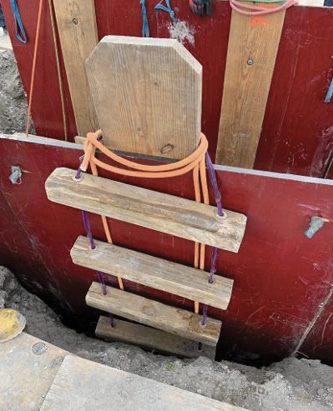
(4) You can loop ladder cribbing over the trench panel and use it to fill voids near the lip of a trench.

(5) A low-pressure lift bag and 6 × 6 lumber are used to fill a large void in the T trench wall.
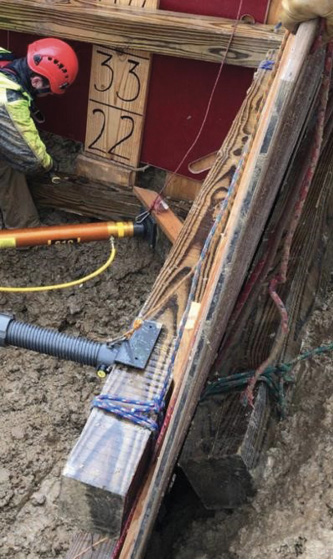
(6) The outside wale is used to give resistance to the trench shores.
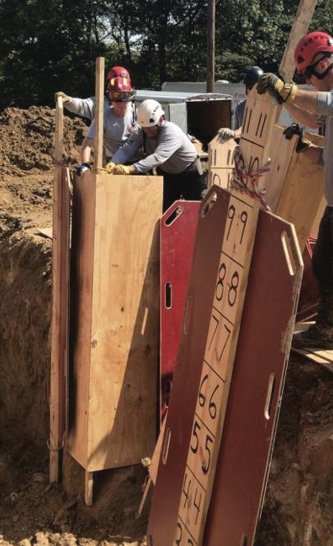
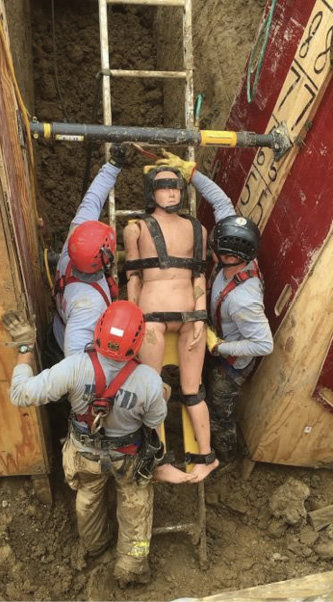
(7, 8) A false corner built from plywood panels keeps soil from running out of the corners of a T trench.
When a large section of trench wall is missing, soil, cribbing or other techniques may not evenly fill the void space. In this situation, try using a 6 × 6 that is eight to 12 feet long—called a waler. Add ropes to each end of the waler, lower it into the area, tie the ropes back to a picket or other sturdy anchor, and place your panel on the inside of the trench so when the shore is pressurized it pushes the panel against the waler. This technique is called using “outside walers” (photo 6).
The corner of a T or L trench is the most likely area to collapse. One technique to capture the soil is to insert a plywood false corner—a structure you place behind the panels and install on the outside soil corners. Create one with two sections of plywood two feet wide × eight feet long and nailed to a 2 × 4 that is eight to 12 feet long (photos 7, 8, and 9). Once you have installed the false corners and the trench shores are soft shot, you can add backfill with soil, cribbing, low-pressure lift bags, or another technique.
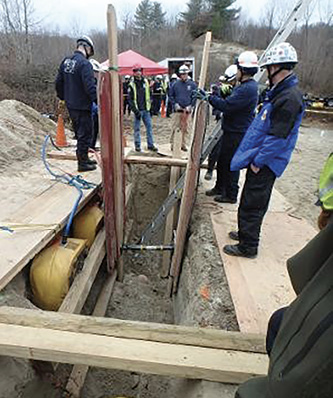
(9) A combination of outside walers and low-pressure lift bags is used to provide resistance to the shores, which allow for proper installation pressure. (Photo by Mark McCabe.)
There is no technique that is always the best fit. Each trench collapse is unique. Often, your team will use a combination of techniques to capture the soil and create a wall that can resist the pressure of the shores, which, in turn, creates a safe zone. Each response team does not carry identical trench rescue equipment. Use these suggestions as more tools in your mental toolbox. Try some of these techniques during training. This may help you to identify or develop more ways to control soil behind your trench panels.
JEREMY RIFFLARD is the lead instructor for the Scaffold Rescue Program and the Structural Collapse Program at the Coral Springs (FL) Regional Institute of Public Safety. He is the program manager for his company TechnicalRescueTraining@yahoo.com. For the past 20 years, he has been a subject matter expert with L2 Defense for first responders and military urban search and rescue exercises. He is a retired captain with the Fort Lauderdale (FL) Fire Department and a rescue team manager for the FEMA Urban Search and Rescue Team FL TF-2. Rifflard’s most recent task force deployments were to the Haitian earthquake and the 2018 Hurricane Michael in Mexico Beach, Florida. He presented on swing-stage scaffold rescue at FDIC International 2019.
MORE JEREMY RIFFLARD
Prebuild Wood Shores for Efficiency

